NURS 3044: Evaluating a Qualitative Study on Childhood Immunization
VerifiedAdded on 2023/06/11
|13
|4216
|371
Report
AI Summary
This report provides a comprehensive assessment of a qualitative research study focusing on parents' perceptions of childhood immunization in Singapore. The analysis covers various aspects of the study, including its purpose, relevance to nursing practice, ethical considerations, methodology, data collection methods, participant recruitment, research findings, and limitations. The assessment evaluates the study's rigor, trustworthiness, and the validity of its conclusions, highlighting both strengths and weaknesses in the research design and execution. The study's findings reveal key factors influencing parents' attitudes toward immunization, such as trust in healthcare systems, fear of adverse effects, and religious beliefs. The report also discusses the implications of these findings for nursing practice and future research in the field of immunization.
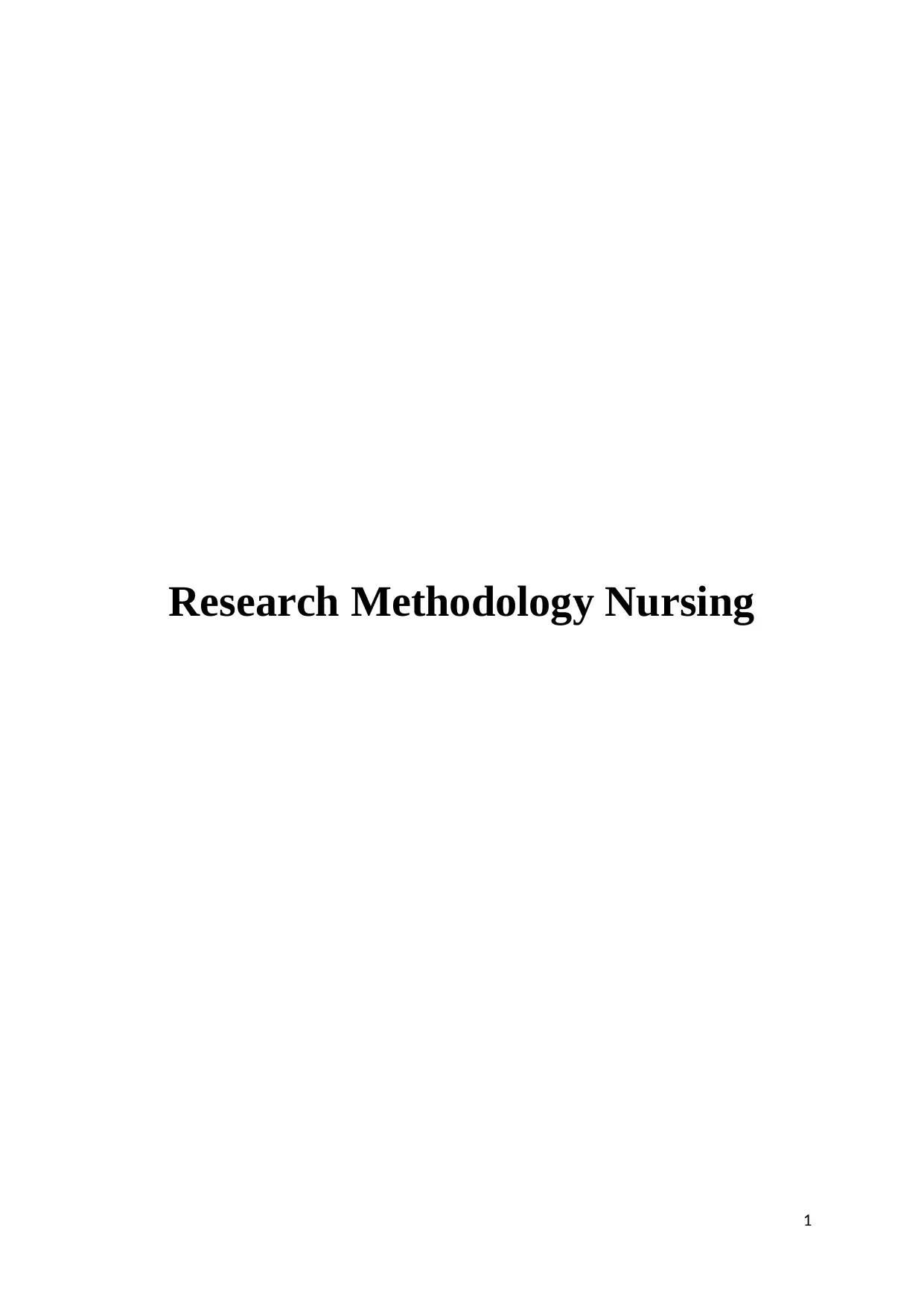
Research Methodology Nursing
1
1
Paraphrase This Document
Need a fresh take? Get an instant paraphrase of this document with our AI Paraphraser

Part 1: Assessing the quality of qualitative research
Question 1: Study Purpose/Question
(a) Did the study have a clearly stated purpose/research question?
Yes
(b) Explain your response below:
Purpose of the study was clearly mentioned in the later part of the introduction and
background section. Authors arrived to the research question or purpose of the study after
performing detailed literature survey. Literature mentioned that parents views on their
children’s vaccination were not explored in an efficient manner. Hence, purpose of this
study was to explore the perceptions of parents on their child’s vaccination in Singapore
to identify gaps in current healthcare practice and therefore help develop future
programmes to improve parents’ experiences regarding their children’s vaccination
(Kurup et al., 2017).
Question 2: Relevance to nursing/midwifery practice
(a) Explain how this question was relevant to nursing/midwifery practice.
Nurse need to interact with parents for effective and timely immunization of the children.
Through communication, nurse can improve parent’s perception towards positive side. It
can be helpful in improving adherence of parents for their children’s immunization. Nurse
can improve parent’s knowledge about immunization. They can also help parents to
reduce their anxiety during painful injection to their children (Holland, 2014).
Question 3: Ethics
(a) What were the possible risks of participating in the study?
Risk identified for the participation of parents in the study were negative perceptions of
parents about impact of immunization on child’s growth, issues while immunization
process, previous negative experience in immunization and religious beliefs
(Kurup et al., 2017).
(b) Were these risks clearly identified by the authors?
No
(c) If risks were identified by the authors, how did they propose to minimise risk?
NA
2
Question 1: Study Purpose/Question
(a) Did the study have a clearly stated purpose/research question?
Yes
(b) Explain your response below:
Purpose of the study was clearly mentioned in the later part of the introduction and
background section. Authors arrived to the research question or purpose of the study after
performing detailed literature survey. Literature mentioned that parents views on their
children’s vaccination were not explored in an efficient manner. Hence, purpose of this
study was to explore the perceptions of parents on their child’s vaccination in Singapore
to identify gaps in current healthcare practice and therefore help develop future
programmes to improve parents’ experiences regarding their children’s vaccination
(Kurup et al., 2017).
Question 2: Relevance to nursing/midwifery practice
(a) Explain how this question was relevant to nursing/midwifery practice.
Nurse need to interact with parents for effective and timely immunization of the children.
Through communication, nurse can improve parent’s perception towards positive side. It
can be helpful in improving adherence of parents for their children’s immunization. Nurse
can improve parent’s knowledge about immunization. They can also help parents to
reduce their anxiety during painful injection to their children (Holland, 2014).
Question 3: Ethics
(a) What were the possible risks of participating in the study?
Risk identified for the participation of parents in the study were negative perceptions of
parents about impact of immunization on child’s growth, issues while immunization
process, previous negative experience in immunization and religious beliefs
(Kurup et al., 2017).
(b) Were these risks clearly identified by the authors?
No
(c) If risks were identified by the authors, how did they propose to minimise risk?
NA
2
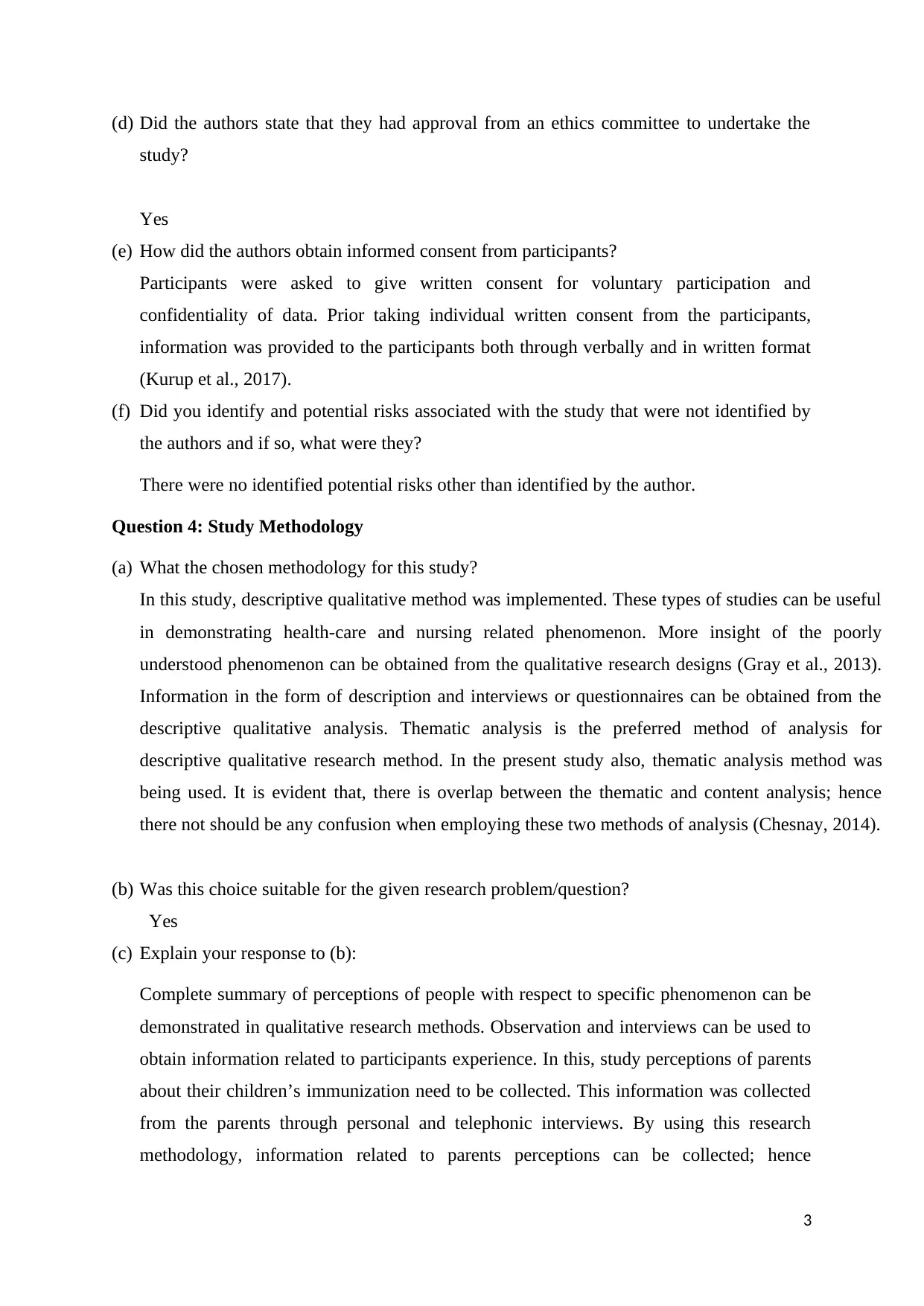
(d) Did the authors state that they had approval from an ethics committee to undertake the
study?
Yes
(e) How did the authors obtain informed consent from participants?
Participants were asked to give written consent for voluntary participation and
confidentiality of data. Prior taking individual written consent from the participants,
information was provided to the participants both through verbally and in written format
(Kurup et al., 2017).
(f) Did you identify and potential risks associated with the study that were not identified by
the authors and if so, what were they?
There were no identified potential risks other than identified by the author.
Question 4: Study Methodology
(a) What the chosen methodology for this study?
In this study, descriptive qualitative method was implemented. These types of studies can be useful
in demonstrating health-care and nursing related phenomenon. More insight of the poorly
understood phenomenon can be obtained from the qualitative research designs (Gray et al., 2013).
Information in the form of description and interviews or questionnaires can be obtained from the
descriptive qualitative analysis. Thematic analysis is the preferred method of analysis for
descriptive qualitative research method. In the present study also, thematic analysis method was
being used. It is evident that, there is overlap between the thematic and content analysis; hence
there not should be any confusion when employing these two methods of analysis (Chesnay, 2014).
(b) Was this choice suitable for the given research problem/question?
Yes
(c) Explain your response to (b):
Complete summary of perceptions of people with respect to specific phenomenon can be
demonstrated in qualitative research methods. Observation and interviews can be used to
obtain information related to participants experience. In this, study perceptions of parents
about their children’s immunization need to be collected. This information was collected
from the parents through personal and telephonic interviews. By using this research
methodology, information related to parents perceptions can be collected; hence
3
study?
Yes
(e) How did the authors obtain informed consent from participants?
Participants were asked to give written consent for voluntary participation and
confidentiality of data. Prior taking individual written consent from the participants,
information was provided to the participants both through verbally and in written format
(Kurup et al., 2017).
(f) Did you identify and potential risks associated with the study that were not identified by
the authors and if so, what were they?
There were no identified potential risks other than identified by the author.
Question 4: Study Methodology
(a) What the chosen methodology for this study?
In this study, descriptive qualitative method was implemented. These types of studies can be useful
in demonstrating health-care and nursing related phenomenon. More insight of the poorly
understood phenomenon can be obtained from the qualitative research designs (Gray et al., 2013).
Information in the form of description and interviews or questionnaires can be obtained from the
descriptive qualitative analysis. Thematic analysis is the preferred method of analysis for
descriptive qualitative research method. In the present study also, thematic analysis method was
being used. It is evident that, there is overlap between the thematic and content analysis; hence
there not should be any confusion when employing these two methods of analysis (Chesnay, 2014).
(b) Was this choice suitable for the given research problem/question?
Yes
(c) Explain your response to (b):
Complete summary of perceptions of people with respect to specific phenomenon can be
demonstrated in qualitative research methods. Observation and interviews can be used to
obtain information related to participants experience. In this, study perceptions of parents
about their children’s immunization need to be collected. This information was collected
from the parents through personal and telephonic interviews. By using this research
methodology, information related to parents perceptions can be collected; hence
3
⊘ This is a preview!⊘
Do you want full access?
Subscribe today to unlock all pages.

Trusted by 1+ million students worldwide
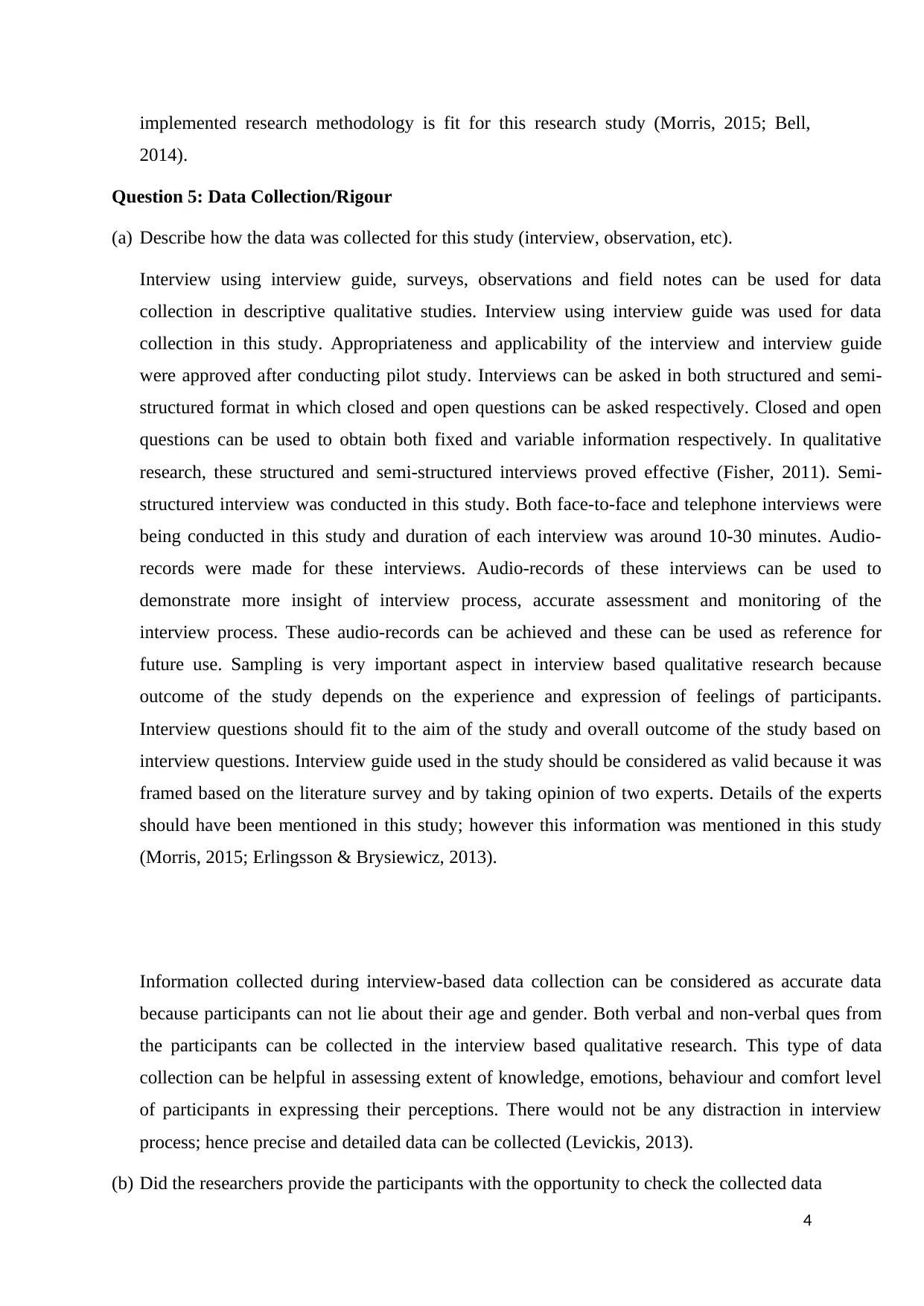
implemented research methodology is fit for this research study (Morris, 2015; Bell,
2014).
Question 5: Data Collection/Rigour
(a) Describe how the data was collected for this study (interview, observation, etc).
Interview using interview guide, surveys, observations and field notes can be used for data
collection in descriptive qualitative studies. Interview using interview guide was used for data
collection in this study. Appropriateness and applicability of the interview and interview guide
were approved after conducting pilot study. Interviews can be asked in both structured and semi-
structured format in which closed and open questions can be asked respectively. Closed and open
questions can be used to obtain both fixed and variable information respectively. In qualitative
research, these structured and semi-structured interviews proved effective (Fisher, 2011). Semi-
structured interview was conducted in this study. Both face-to-face and telephone interviews were
being conducted in this study and duration of each interview was around 10-30 minutes. Audio-
records were made for these interviews. Audio-records of these interviews can be used to
demonstrate more insight of interview process, accurate assessment and monitoring of the
interview process. These audio-records can be achieved and these can be used as reference for
future use. Sampling is very important aspect in interview based qualitative research because
outcome of the study depends on the experience and expression of feelings of participants.
Interview questions should fit to the aim of the study and overall outcome of the study based on
interview questions. Interview guide used in the study should be considered as valid because it was
framed based on the literature survey and by taking opinion of two experts. Details of the experts
should have been mentioned in this study; however this information was mentioned in this study
(Morris, 2015; Erlingsson & Brysiewicz, 2013).
Information collected during interview-based data collection can be considered as accurate data
because participants can not lie about their age and gender. Both verbal and non-verbal ques from
the participants can be collected in the interview based qualitative research. This type of data
collection can be helpful in assessing extent of knowledge, emotions, behaviour and comfort level
of participants in expressing their perceptions. There would not be any distraction in interview
process; hence precise and detailed data can be collected (Levickis, 2013).
(b) Did the researchers provide the participants with the opportunity to check the collected data
4
2014).
Question 5: Data Collection/Rigour
(a) Describe how the data was collected for this study (interview, observation, etc).
Interview using interview guide, surveys, observations and field notes can be used for data
collection in descriptive qualitative studies. Interview using interview guide was used for data
collection in this study. Appropriateness and applicability of the interview and interview guide
were approved after conducting pilot study. Interviews can be asked in both structured and semi-
structured format in which closed and open questions can be asked respectively. Closed and open
questions can be used to obtain both fixed and variable information respectively. In qualitative
research, these structured and semi-structured interviews proved effective (Fisher, 2011). Semi-
structured interview was conducted in this study. Both face-to-face and telephone interviews were
being conducted in this study and duration of each interview was around 10-30 minutes. Audio-
records were made for these interviews. Audio-records of these interviews can be used to
demonstrate more insight of interview process, accurate assessment and monitoring of the
interview process. These audio-records can be achieved and these can be used as reference for
future use. Sampling is very important aspect in interview based qualitative research because
outcome of the study depends on the experience and expression of feelings of participants.
Interview questions should fit to the aim of the study and overall outcome of the study based on
interview questions. Interview guide used in the study should be considered as valid because it was
framed based on the literature survey and by taking opinion of two experts. Details of the experts
should have been mentioned in this study; however this information was mentioned in this study
(Morris, 2015; Erlingsson & Brysiewicz, 2013).
Information collected during interview-based data collection can be considered as accurate data
because participants can not lie about their age and gender. Both verbal and non-verbal ques from
the participants can be collected in the interview based qualitative research. This type of data
collection can be helpful in assessing extent of knowledge, emotions, behaviour and comfort level
of participants in expressing their perceptions. There would not be any distraction in interview
process; hence precise and detailed data can be collected (Levickis, 2013).
(b) Did the researchers provide the participants with the opportunity to check the collected data
4
Paraphrase This Document
Need a fresh take? Get an instant paraphrase of this document with our AI Paraphraser

or research findings?
No
(c) Did the researchers continue recruiting people to the study until data saturation was
reached?
Yes
(d) Did the study use multiple data collection methods (eg collect data from more than one
source)? No
(e) Explain how the points in (b), (c) and (d) contribute to the trustworthiness of the overall
research findings.
Participants should not be allowed to check the data. Biasness can be reduced and rigour
can be improved for the collected data by blinding participants for the collected data.
Inclusion and exclusion criteria were considered for the recruitment of the participants at
the start of the study (Isaacs, 2014). Participants were recruited until saturation of the
data. It indicates that new data was not collected. Hence, collected data was valid and it
can improve trustworthiness of the study. Biasness can be reduced by collecting data by
the experts in the field and blinding of the researchers for the participants. In this study
also, data was collected by senior researcher who was not participated in the study. One
researcher was involved in the data collection; hence inconsistency in the data was
reduced. Trustworthiness of the findings were incorporated by considering all these
aspects (Fisher, 2011).
Question 6: Participants
(a) How many participants were included in the study?
22 participants were recruited and data was collected for 19 participants. One participant was used
for pilot study and two participants were withdrawn from the study. Number of participants were
mentioned in the data collection section of the article. It could have been mentioned in the
sampling or methodology section of the article.
(b) What were the inclusion and exclusion criteria?
5
No
(c) Did the researchers continue recruiting people to the study until data saturation was
reached?
Yes
(d) Did the study use multiple data collection methods (eg collect data from more than one
source)? No
(e) Explain how the points in (b), (c) and (d) contribute to the trustworthiness of the overall
research findings.
Participants should not be allowed to check the data. Biasness can be reduced and rigour
can be improved for the collected data by blinding participants for the collected data.
Inclusion and exclusion criteria were considered for the recruitment of the participants at
the start of the study (Isaacs, 2014). Participants were recruited until saturation of the
data. It indicates that new data was not collected. Hence, collected data was valid and it
can improve trustworthiness of the study. Biasness can be reduced by collecting data by
the experts in the field and blinding of the researchers for the participants. In this study
also, data was collected by senior researcher who was not participated in the study. One
researcher was involved in the data collection; hence inconsistency in the data was
reduced. Trustworthiness of the findings were incorporated by considering all these
aspects (Fisher, 2011).
Question 6: Participants
(a) How many participants were included in the study?
22 participants were recruited and data was collected for 19 participants. One participant was used
for pilot study and two participants were withdrawn from the study. Number of participants were
mentioned in the data collection section of the article. It could have been mentioned in the
sampling or methodology section of the article.
(b) What were the inclusion and exclusion criteria?
5
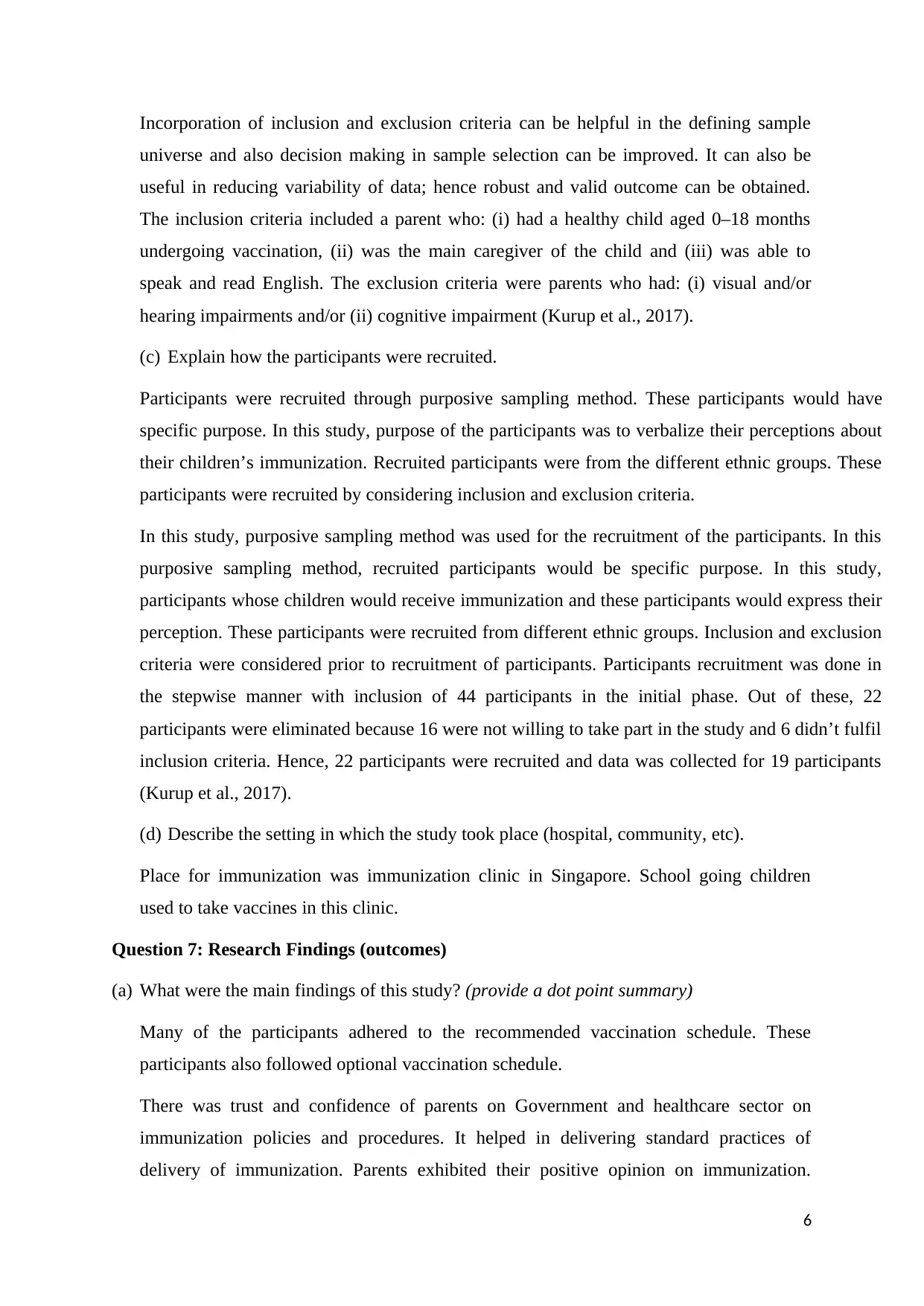
Incorporation of inclusion and exclusion criteria can be helpful in the defining sample
universe and also decision making in sample selection can be improved. It can also be
useful in reducing variability of data; hence robust and valid outcome can be obtained.
The inclusion criteria included a parent who: (i) had a healthy child aged 0–18 months
undergoing vaccination, (ii) was the main caregiver of the child and (iii) was able to
speak and read English. The exclusion criteria were parents who had: (i) visual and/or
hearing impairments and/or (ii) cognitive impairment (Kurup et al., 2017).
(c) Explain how the participants were recruited.
Participants were recruited through purposive sampling method. These participants would have
specific purpose. In this study, purpose of the participants was to verbalize their perceptions about
their children’s immunization. Recruited participants were from the different ethnic groups. These
participants were recruited by considering inclusion and exclusion criteria.
In this study, purposive sampling method was used for the recruitment of the participants. In this
purposive sampling method, recruited participants would be specific purpose. In this study,
participants whose children would receive immunization and these participants would express their
perception. These participants were recruited from different ethnic groups. Inclusion and exclusion
criteria were considered prior to recruitment of participants. Participants recruitment was done in
the stepwise manner with inclusion of 44 participants in the initial phase. Out of these, 22
participants were eliminated because 16 were not willing to take part in the study and 6 didn’t fulfil
inclusion criteria. Hence, 22 participants were recruited and data was collected for 19 participants
(Kurup et al., 2017).
(d) Describe the setting in which the study took place (hospital, community, etc).
Place for immunization was immunization clinic in Singapore. School going children
used to take vaccines in this clinic.
Question 7: Research Findings (outcomes)
(a) What were the main findings of this study? (provide a dot point summary)
Many of the participants adhered to the recommended vaccination schedule. These
participants also followed optional vaccination schedule.
There was trust and confidence of parents on Government and healthcare sector on
immunization policies and procedures. It helped in delivering standard practices of
delivery of immunization. Parents exhibited their positive opinion on immunization.
6
universe and also decision making in sample selection can be improved. It can also be
useful in reducing variability of data; hence robust and valid outcome can be obtained.
The inclusion criteria included a parent who: (i) had a healthy child aged 0–18 months
undergoing vaccination, (ii) was the main caregiver of the child and (iii) was able to
speak and read English. The exclusion criteria were parents who had: (i) visual and/or
hearing impairments and/or (ii) cognitive impairment (Kurup et al., 2017).
(c) Explain how the participants were recruited.
Participants were recruited through purposive sampling method. These participants would have
specific purpose. In this study, purpose of the participants was to verbalize their perceptions about
their children’s immunization. Recruited participants were from the different ethnic groups. These
participants were recruited by considering inclusion and exclusion criteria.
In this study, purposive sampling method was used for the recruitment of the participants. In this
purposive sampling method, recruited participants would be specific purpose. In this study,
participants whose children would receive immunization and these participants would express their
perception. These participants were recruited from different ethnic groups. Inclusion and exclusion
criteria were considered prior to recruitment of participants. Participants recruitment was done in
the stepwise manner with inclusion of 44 participants in the initial phase. Out of these, 22
participants were eliminated because 16 were not willing to take part in the study and 6 didn’t fulfil
inclusion criteria. Hence, 22 participants were recruited and data was collected for 19 participants
(Kurup et al., 2017).
(d) Describe the setting in which the study took place (hospital, community, etc).
Place for immunization was immunization clinic in Singapore. School going children
used to take vaccines in this clinic.
Question 7: Research Findings (outcomes)
(a) What were the main findings of this study? (provide a dot point summary)
Many of the participants adhered to the recommended vaccination schedule. These
participants also followed optional vaccination schedule.
There was trust and confidence of parents on Government and healthcare sector on
immunization policies and procedures. It helped in delivering standard practices of
delivery of immunization. Parents exhibited their positive opinion on immunization.
6
⊘ This is a preview!⊘
Do you want full access?
Subscribe today to unlock all pages.

Trusted by 1+ million students worldwide
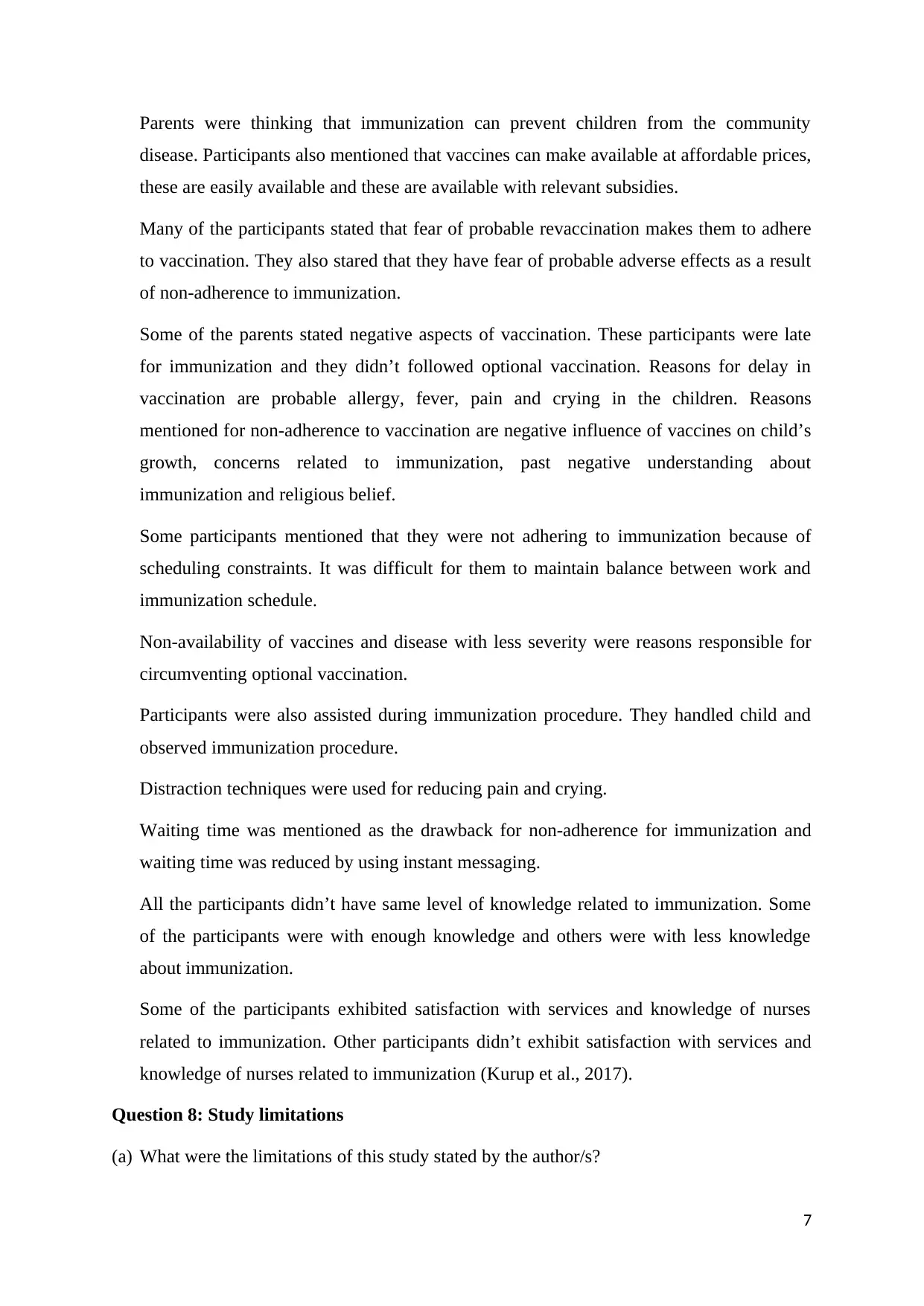
Parents were thinking that immunization can prevent children from the community
disease. Participants also mentioned that vaccines can make available at affordable prices,
these are easily available and these are available with relevant subsidies.
Many of the participants stated that fear of probable revaccination makes them to adhere
to vaccination. They also stared that they have fear of probable adverse effects as a result
of non-adherence to immunization.
Some of the parents stated negative aspects of vaccination. These participants were late
for immunization and they didn’t followed optional vaccination. Reasons for delay in
vaccination are probable allergy, fever, pain and crying in the children. Reasons
mentioned for non-adherence to vaccination are negative influence of vaccines on child’s
growth, concerns related to immunization, past negative understanding about
immunization and religious belief.
Some participants mentioned that they were not adhering to immunization because of
scheduling constraints. It was difficult for them to maintain balance between work and
immunization schedule.
Non-availability of vaccines and disease with less severity were reasons responsible for
circumventing optional vaccination.
Participants were also assisted during immunization procedure. They handled child and
observed immunization procedure.
Distraction techniques were used for reducing pain and crying.
Waiting time was mentioned as the drawback for non-adherence for immunization and
waiting time was reduced by using instant messaging.
All the participants didn’t have same level of knowledge related to immunization. Some
of the participants were with enough knowledge and others were with less knowledge
about immunization.
Some of the participants exhibited satisfaction with services and knowledge of nurses
related to immunization. Other participants didn’t exhibit satisfaction with services and
knowledge of nurses related to immunization (Kurup et al., 2017).
Question 8: Study limitations
(a) What were the limitations of this study stated by the author/s?
7
disease. Participants also mentioned that vaccines can make available at affordable prices,
these are easily available and these are available with relevant subsidies.
Many of the participants stated that fear of probable revaccination makes them to adhere
to vaccination. They also stared that they have fear of probable adverse effects as a result
of non-adherence to immunization.
Some of the parents stated negative aspects of vaccination. These participants were late
for immunization and they didn’t followed optional vaccination. Reasons for delay in
vaccination are probable allergy, fever, pain and crying in the children. Reasons
mentioned for non-adherence to vaccination are negative influence of vaccines on child’s
growth, concerns related to immunization, past negative understanding about
immunization and religious belief.
Some participants mentioned that they were not adhering to immunization because of
scheduling constraints. It was difficult for them to maintain balance between work and
immunization schedule.
Non-availability of vaccines and disease with less severity were reasons responsible for
circumventing optional vaccination.
Participants were also assisted during immunization procedure. They handled child and
observed immunization procedure.
Distraction techniques were used for reducing pain and crying.
Waiting time was mentioned as the drawback for non-adherence for immunization and
waiting time was reduced by using instant messaging.
All the participants didn’t have same level of knowledge related to immunization. Some
of the participants were with enough knowledge and others were with less knowledge
about immunization.
Some of the participants exhibited satisfaction with services and knowledge of nurses
related to immunization. Other participants didn’t exhibit satisfaction with services and
knowledge of nurses related to immunization (Kurup et al., 2017).
Question 8: Study limitations
(a) What were the limitations of this study stated by the author/s?
7
Paraphrase This Document
Need a fresh take? Get an instant paraphrase of this document with our AI Paraphraser
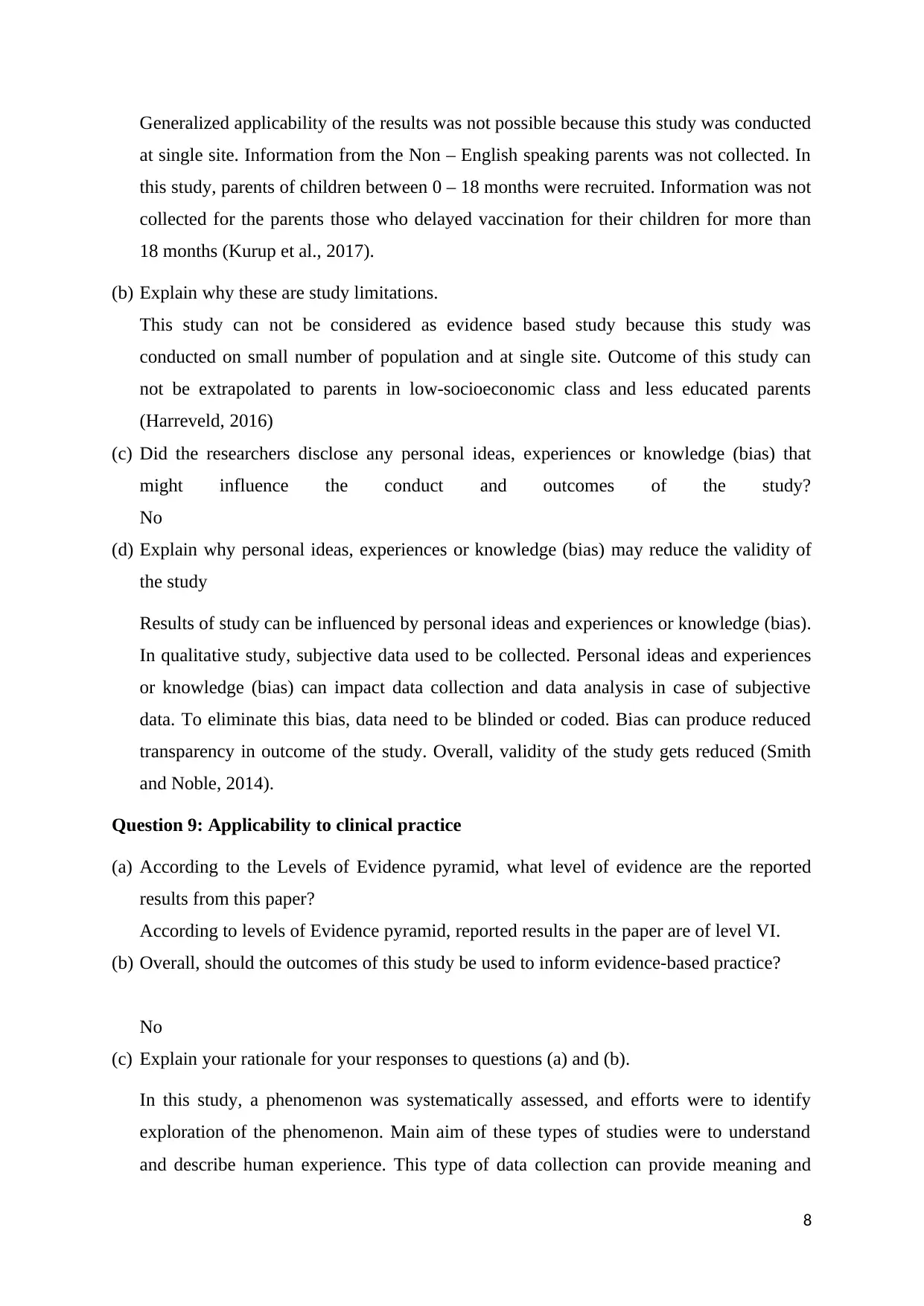
Generalized applicability of the results was not possible because this study was conducted
at single site. Information from the Non – English speaking parents was not collected. In
this study, parents of children between 0 – 18 months were recruited. Information was not
collected for the parents those who delayed vaccination for their children for more than
18 months (Kurup et al., 2017).
(b) Explain why these are study limitations.
This study can not be considered as evidence based study because this study was
conducted on small number of population and at single site. Outcome of this study can
not be extrapolated to parents in low-socioeconomic class and less educated parents
(Harreveld, 2016)
(c) Did the researchers disclose any personal ideas, experiences or knowledge (bias) that
might influence the conduct and outcomes of the study?
No
(d) Explain why personal ideas, experiences or knowledge (bias) may reduce the validity of
the study
Results of study can be influenced by personal ideas and experiences or knowledge (bias).
In qualitative study, subjective data used to be collected. Personal ideas and experiences
or knowledge (bias) can impact data collection and data analysis in case of subjective
data. To eliminate this bias, data need to be blinded or coded. Bias can produce reduced
transparency in outcome of the study. Overall, validity of the study gets reduced (Smith
and Noble, 2014).
Question 9: Applicability to clinical practice
(a) According to the Levels of Evidence pyramid, what level of evidence are the reported
results from this paper?
According to levels of Evidence pyramid, reported results in the paper are of level VI.
(b) Overall, should the outcomes of this study be used to inform evidence-based practice?
No
(c) Explain your rationale for your responses to questions (a) and (b).
In this study, a phenomenon was systematically assessed, and efforts were to identify
exploration of the phenomenon. Main aim of these types of studies were to understand
and describe human experience. This type of data collection can provide meaning and
8
at single site. Information from the Non – English speaking parents was not collected. In
this study, parents of children between 0 – 18 months were recruited. Information was not
collected for the parents those who delayed vaccination for their children for more than
18 months (Kurup et al., 2017).
(b) Explain why these are study limitations.
This study can not be considered as evidence based study because this study was
conducted on small number of population and at single site. Outcome of this study can
not be extrapolated to parents in low-socioeconomic class and less educated parents
(Harreveld, 2016)
(c) Did the researchers disclose any personal ideas, experiences or knowledge (bias) that
might influence the conduct and outcomes of the study?
No
(d) Explain why personal ideas, experiences or knowledge (bias) may reduce the validity of
the study
Results of study can be influenced by personal ideas and experiences or knowledge (bias).
In qualitative study, subjective data used to be collected. Personal ideas and experiences
or knowledge (bias) can impact data collection and data analysis in case of subjective
data. To eliminate this bias, data need to be blinded or coded. Bias can produce reduced
transparency in outcome of the study. Overall, validity of the study gets reduced (Smith
and Noble, 2014).
Question 9: Applicability to clinical practice
(a) According to the Levels of Evidence pyramid, what level of evidence are the reported
results from this paper?
According to levels of Evidence pyramid, reported results in the paper are of level VI.
(b) Overall, should the outcomes of this study be used to inform evidence-based practice?
No
(c) Explain your rationale for your responses to questions (a) and (b).
In this study, a phenomenon was systematically assessed, and efforts were to identify
exploration of the phenomenon. Main aim of these types of studies were to understand
and describe human experience. This type of data collection can provide meaning and
8
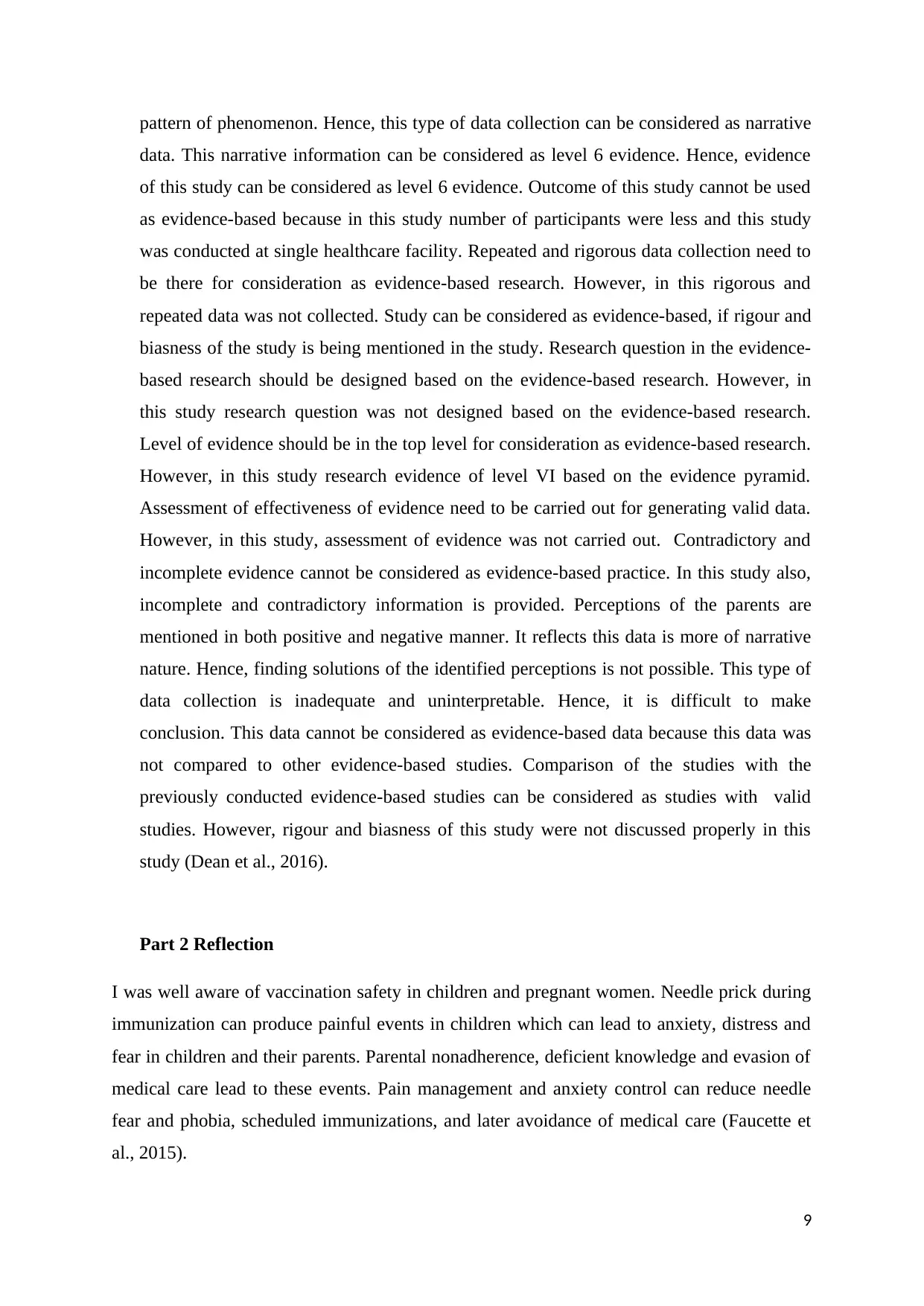
pattern of phenomenon. Hence, this type of data collection can be considered as narrative
data. This narrative information can be considered as level 6 evidence. Hence, evidence
of this study can be considered as level 6 evidence. Outcome of this study cannot be used
as evidence-based because in this study number of participants were less and this study
was conducted at single healthcare facility. Repeated and rigorous data collection need to
be there for consideration as evidence-based research. However, in this rigorous and
repeated data was not collected. Study can be considered as evidence-based, if rigour and
biasness of the study is being mentioned in the study. Research question in the evidence-
based research should be designed based on the evidence-based research. However, in
this study research question was not designed based on the evidence-based research.
Level of evidence should be in the top level for consideration as evidence-based research.
However, in this study research evidence of level VI based on the evidence pyramid.
Assessment of effectiveness of evidence need to be carried out for generating valid data.
However, in this study, assessment of evidence was not carried out. Contradictory and
incomplete evidence cannot be considered as evidence-based practice. In this study also,
incomplete and contradictory information is provided. Perceptions of the parents are
mentioned in both positive and negative manner. It reflects this data is more of narrative
nature. Hence, finding solutions of the identified perceptions is not possible. This type of
data collection is inadequate and uninterpretable. Hence, it is difficult to make
conclusion. This data cannot be considered as evidence-based data because this data was
not compared to other evidence-based studies. Comparison of the studies with the
previously conducted evidence-based studies can be considered as studies with valid
studies. However, rigour and biasness of this study were not discussed properly in this
study (Dean et al., 2016).
Part 2 Reflection
I was well aware of vaccination safety in children and pregnant women. Needle prick during
immunization can produce painful events in children which can lead to anxiety, distress and
fear in children and their parents. Parental nonadherence, deficient knowledge and evasion of
medical care lead to these events. Pain management and anxiety control can reduce needle
fear and phobia, scheduled immunizations, and later avoidance of medical care (Faucette et
al., 2015).
9
data. This narrative information can be considered as level 6 evidence. Hence, evidence
of this study can be considered as level 6 evidence. Outcome of this study cannot be used
as evidence-based because in this study number of participants were less and this study
was conducted at single healthcare facility. Repeated and rigorous data collection need to
be there for consideration as evidence-based research. However, in this rigorous and
repeated data was not collected. Study can be considered as evidence-based, if rigour and
biasness of the study is being mentioned in the study. Research question in the evidence-
based research should be designed based on the evidence-based research. However, in
this study research question was not designed based on the evidence-based research.
Level of evidence should be in the top level for consideration as evidence-based research.
However, in this study research evidence of level VI based on the evidence pyramid.
Assessment of effectiveness of evidence need to be carried out for generating valid data.
However, in this study, assessment of evidence was not carried out. Contradictory and
incomplete evidence cannot be considered as evidence-based practice. In this study also,
incomplete and contradictory information is provided. Perceptions of the parents are
mentioned in both positive and negative manner. It reflects this data is more of narrative
nature. Hence, finding solutions of the identified perceptions is not possible. This type of
data collection is inadequate and uninterpretable. Hence, it is difficult to make
conclusion. This data cannot be considered as evidence-based data because this data was
not compared to other evidence-based studies. Comparison of the studies with the
previously conducted evidence-based studies can be considered as studies with valid
studies. However, rigour and biasness of this study were not discussed properly in this
study (Dean et al., 2016).
Part 2 Reflection
I was well aware of vaccination safety in children and pregnant women. Needle prick during
immunization can produce painful events in children which can lead to anxiety, distress and
fear in children and their parents. Parental nonadherence, deficient knowledge and evasion of
medical care lead to these events. Pain management and anxiety control can reduce needle
fear and phobia, scheduled immunizations, and later avoidance of medical care (Faucette et
al., 2015).
9
⊘ This is a preview!⊘
Do you want full access?
Subscribe today to unlock all pages.

Trusted by 1+ million students worldwide
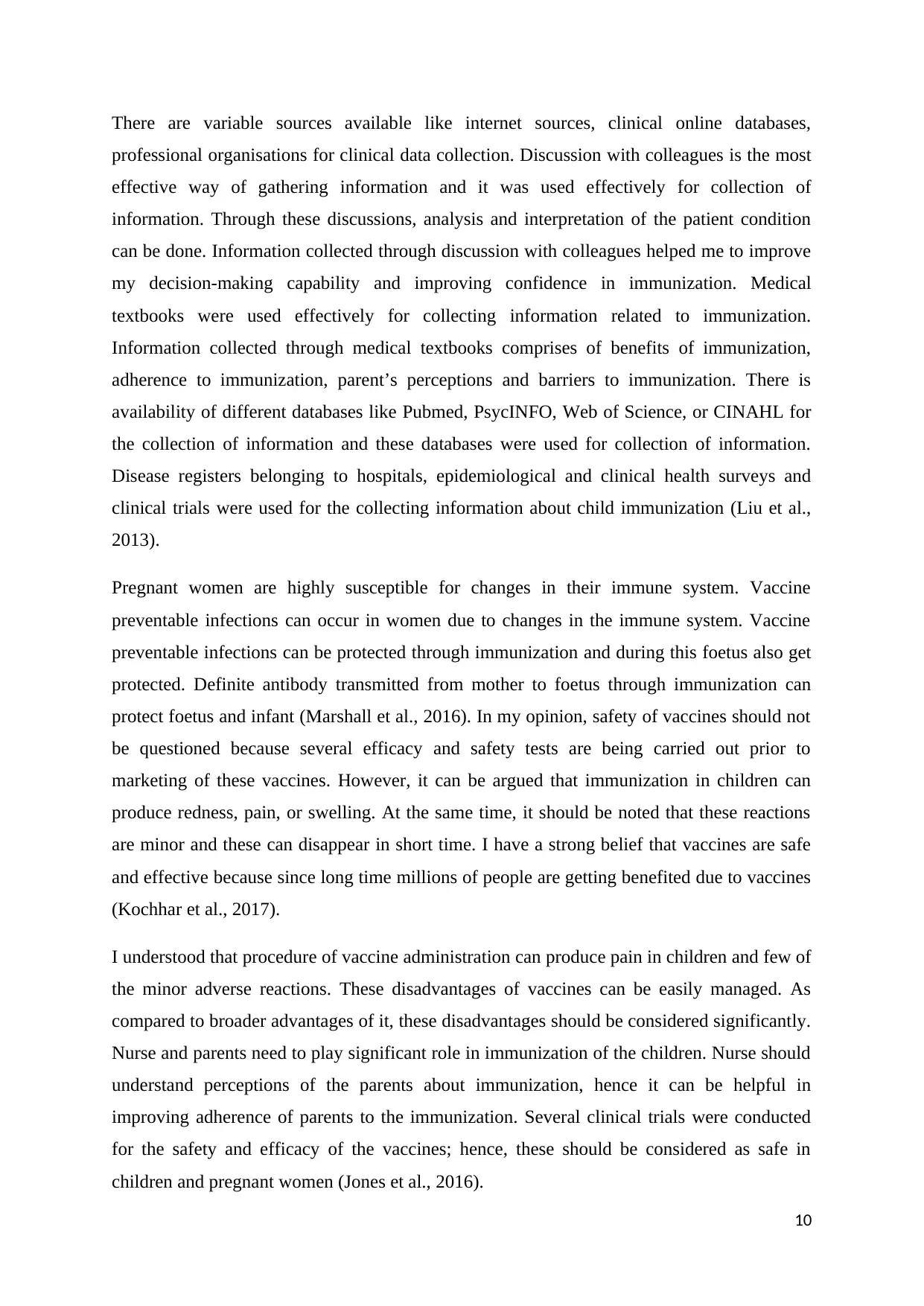
There are variable sources available like internet sources, clinical online databases,
professional organisations for clinical data collection. Discussion with colleagues is the most
effective way of gathering information and it was used effectively for collection of
information. Through these discussions, analysis and interpretation of the patient condition
can be done. Information collected through discussion with colleagues helped me to improve
my decision-making capability and improving confidence in immunization. Medical
textbooks were used effectively for collecting information related to immunization.
Information collected through medical textbooks comprises of benefits of immunization,
adherence to immunization, parent’s perceptions and barriers to immunization. There is
availability of different databases like Pubmed, PsycINFO, Web of Science, or CINAHL for
the collection of information and these databases were used for collection of information.
Disease registers belonging to hospitals, epidemiological and clinical health surveys and
clinical trials were used for the collecting information about child immunization (Liu et al.,
2013).
Pregnant women are highly susceptible for changes in their immune system. Vaccine
preventable infections can occur in women due to changes in the immune system. Vaccine
preventable infections can be protected through immunization and during this foetus also get
protected. Definite antibody transmitted from mother to foetus through immunization can
protect foetus and infant (Marshall et al., 2016). In my opinion, safety of vaccines should not
be questioned because several efficacy and safety tests are being carried out prior to
marketing of these vaccines. However, it can be argued that immunization in children can
produce redness, pain, or swelling. At the same time, it should be noted that these reactions
are minor and these can disappear in short time. I have a strong belief that vaccines are safe
and effective because since long time millions of people are getting benefited due to vaccines
(Kochhar et al., 2017).
I understood that procedure of vaccine administration can produce pain in children and few of
the minor adverse reactions. These disadvantages of vaccines can be easily managed. As
compared to broader advantages of it, these disadvantages should be considered significantly.
Nurse and parents need to play significant role in immunization of the children. Nurse should
understand perceptions of the parents about immunization, hence it can be helpful in
improving adherence of parents to the immunization. Several clinical trials were conducted
for the safety and efficacy of the vaccines; hence, these should be considered as safe in
children and pregnant women (Jones et al., 2016).
10
professional organisations for clinical data collection. Discussion with colleagues is the most
effective way of gathering information and it was used effectively for collection of
information. Through these discussions, analysis and interpretation of the patient condition
can be done. Information collected through discussion with colleagues helped me to improve
my decision-making capability and improving confidence in immunization. Medical
textbooks were used effectively for collecting information related to immunization.
Information collected through medical textbooks comprises of benefits of immunization,
adherence to immunization, parent’s perceptions and barriers to immunization. There is
availability of different databases like Pubmed, PsycINFO, Web of Science, or CINAHL for
the collection of information and these databases were used for collection of information.
Disease registers belonging to hospitals, epidemiological and clinical health surveys and
clinical trials were used for the collecting information about child immunization (Liu et al.,
2013).
Pregnant women are highly susceptible for changes in their immune system. Vaccine
preventable infections can occur in women due to changes in the immune system. Vaccine
preventable infections can be protected through immunization and during this foetus also get
protected. Definite antibody transmitted from mother to foetus through immunization can
protect foetus and infant (Marshall et al., 2016). In my opinion, safety of vaccines should not
be questioned because several efficacy and safety tests are being carried out prior to
marketing of these vaccines. However, it can be argued that immunization in children can
produce redness, pain, or swelling. At the same time, it should be noted that these reactions
are minor and these can disappear in short time. I have a strong belief that vaccines are safe
and effective because since long time millions of people are getting benefited due to vaccines
(Kochhar et al., 2017).
I understood that procedure of vaccine administration can produce pain in children and few of
the minor adverse reactions. These disadvantages of vaccines can be easily managed. As
compared to broader advantages of it, these disadvantages should be considered significantly.
Nurse and parents need to play significant role in immunization of the children. Nurse should
understand perceptions of the parents about immunization, hence it can be helpful in
improving adherence of parents to the immunization. Several clinical trials were conducted
for the safety and efficacy of the vaccines; hence, these should be considered as safe in
children and pregnant women (Jones et al., 2016).
10
Paraphrase This Document
Need a fresh take? Get an instant paraphrase of this document with our AI Paraphraser

11
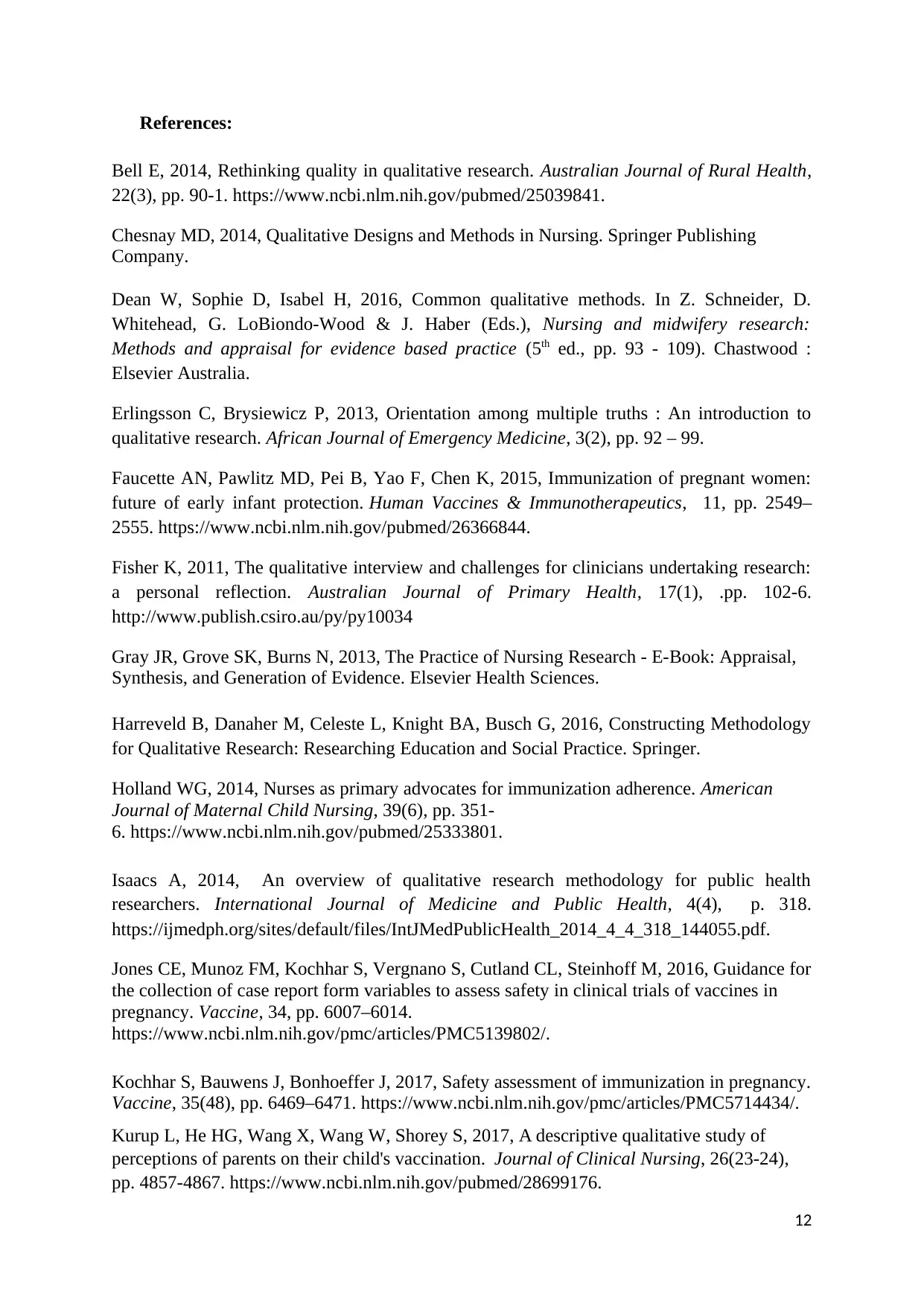
References:
Bell E, 2014, Rethinking quality in qualitative research. Australian Journal of Rural Health,
22(3), pp. 90-1. https://www.ncbi.nlm.nih.gov/pubmed/25039841.
Chesnay MD, 2014, Qualitative Designs and Methods in Nursing. Springer Publishing
Company.
Dean W, Sophie D, Isabel H, 2016, Common qualitative methods. In Z. Schneider, D.
Whitehead, G. LoBiondo-Wood & J. Haber (Eds.), Nursing and midwifery research:
Methods and appraisal for evidence based practice (5th ed., pp. 93 - 109). Chastwood :
Elsevier Australia.
Erlingsson C, Brysiewicz P, 2013, Orientation among multiple truths : An introduction to
qualitative research. African Journal of Emergency Medicine, 3(2), pp. 92 – 99.
Faucette AN, Pawlitz MD, Pei B, Yao F, Chen K, 2015, Immunization of pregnant women:
future of early infant protection. Human Vaccines & Immunotherapeutics, 11, pp. 2549–
2555. https://www.ncbi.nlm.nih.gov/pubmed/26366844.
Fisher K, 2011, The qualitative interview and challenges for clinicians undertaking research:
a personal reflection. Australian Journal of Primary Health, 17(1), .pp. 102-6.
http://www.publish.csiro.au/py/py10034
Gray JR, Grove SK, Burns N, 2013, The Practice of Nursing Research - E-Book: Appraisal,
Synthesis, and Generation of Evidence. Elsevier Health Sciences.
Harreveld B, Danaher M, Celeste L, Knight BA, Busch G, 2016, Constructing Methodology
for Qualitative Research: Researching Education and Social Practice. Springer.
Holland WG, 2014, Nurses as primary advocates for immunization adherence. American
Journal of Maternal Child Nursing, 39(6), pp. 351-
6. https://www.ncbi.nlm.nih.gov/pubmed/25333801.
Isaacs A, 2014, An overview of qualitative research methodology for public health
researchers. International Journal of Medicine and Public Health, 4(4), p. 318.
https://ijmedph.org/sites/default/files/IntJMedPublicHealth_2014_4_4_318_144055.pdf.
Jones CE, Munoz FM, Kochhar S, Vergnano S, Cutland CL, Steinhoff M, 2016, Guidance for
the collection of case report form variables to assess safety in clinical trials of vaccines in
pregnancy. Vaccine, 34, pp. 6007–6014.
https://www.ncbi.nlm.nih.gov/pmc/articles/PMC5139802/.
Kochhar S, Bauwens J, Bonhoeffer J, 2017, Safety assessment of immunization in pregnancy.
Vaccine, 35(48), pp. 6469–6471. https://www.ncbi.nlm.nih.gov/pmc/articles/PMC5714434/.
Kurup L, He HG, Wang X, Wang W, Shorey S, 2017, A descriptive qualitative study of
perceptions of parents on their child's vaccination. Journal of Clinical Nursing, 26(23-24),
pp. 4857-4867. https://www.ncbi.nlm.nih.gov/pubmed/28699176.
12
Bell E, 2014, Rethinking quality in qualitative research. Australian Journal of Rural Health,
22(3), pp. 90-1. https://www.ncbi.nlm.nih.gov/pubmed/25039841.
Chesnay MD, 2014, Qualitative Designs and Methods in Nursing. Springer Publishing
Company.
Dean W, Sophie D, Isabel H, 2016, Common qualitative methods. In Z. Schneider, D.
Whitehead, G. LoBiondo-Wood & J. Haber (Eds.), Nursing and midwifery research:
Methods and appraisal for evidence based practice (5th ed., pp. 93 - 109). Chastwood :
Elsevier Australia.
Erlingsson C, Brysiewicz P, 2013, Orientation among multiple truths : An introduction to
qualitative research. African Journal of Emergency Medicine, 3(2), pp. 92 – 99.
Faucette AN, Pawlitz MD, Pei B, Yao F, Chen K, 2015, Immunization of pregnant women:
future of early infant protection. Human Vaccines & Immunotherapeutics, 11, pp. 2549–
2555. https://www.ncbi.nlm.nih.gov/pubmed/26366844.
Fisher K, 2011, The qualitative interview and challenges for clinicians undertaking research:
a personal reflection. Australian Journal of Primary Health, 17(1), .pp. 102-6.
http://www.publish.csiro.au/py/py10034
Gray JR, Grove SK, Burns N, 2013, The Practice of Nursing Research - E-Book: Appraisal,
Synthesis, and Generation of Evidence. Elsevier Health Sciences.
Harreveld B, Danaher M, Celeste L, Knight BA, Busch G, 2016, Constructing Methodology
for Qualitative Research: Researching Education and Social Practice. Springer.
Holland WG, 2014, Nurses as primary advocates for immunization adherence. American
Journal of Maternal Child Nursing, 39(6), pp. 351-
6. https://www.ncbi.nlm.nih.gov/pubmed/25333801.
Isaacs A, 2014, An overview of qualitative research methodology for public health
researchers. International Journal of Medicine and Public Health, 4(4), p. 318.
https://ijmedph.org/sites/default/files/IntJMedPublicHealth_2014_4_4_318_144055.pdf.
Jones CE, Munoz FM, Kochhar S, Vergnano S, Cutland CL, Steinhoff M, 2016, Guidance for
the collection of case report form variables to assess safety in clinical trials of vaccines in
pregnancy. Vaccine, 34, pp. 6007–6014.
https://www.ncbi.nlm.nih.gov/pmc/articles/PMC5139802/.
Kochhar S, Bauwens J, Bonhoeffer J, 2017, Safety assessment of immunization in pregnancy.
Vaccine, 35(48), pp. 6469–6471. https://www.ncbi.nlm.nih.gov/pmc/articles/PMC5714434/.
Kurup L, He HG, Wang X, Wang W, Shorey S, 2017, A descriptive qualitative study of
perceptions of parents on their child's vaccination. Journal of Clinical Nursing, 26(23-24),
pp. 4857-4867. https://www.ncbi.nlm.nih.gov/pubmed/28699176.
12
⊘ This is a preview!⊘
Do you want full access?
Subscribe today to unlock all pages.

Trusted by 1+ million students worldwide
1 out of 13